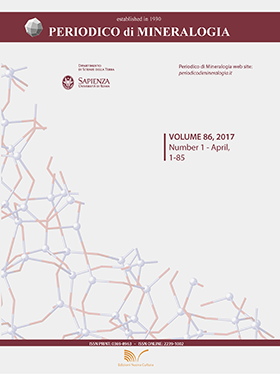Spherulite formation in obsidian lavas in the Aeolian Islands, Italy
DOI:
https://doi.org/10.2451/2017PM680Keywords:
Spherulites, Obsidian, Aeolian Islands, Glass Transition, Lipari, VulcanoAbstract
Spherulites in obsidian lavas of Lipari and Vulcano (Italy) are characterised by spatial, textural and geochemical variations, formed by different processes. Spherulites vary in size from <1 mm to 8 mm, are spherical to elongate in shape, and show variable radial interiors. Spherulites occur individually or in
deformation bands, and some are surrounded by clear haloes and brown rims. Spherulites typically contain cristobalite (α, β) and orthoclase, titanomagnetite and rhyolitic glass, and grew over an average period of 5 days, with modification over a few hundred years at lower temperatures. Heterogeneity relates to
formation processes of spherulite ‘types’ at different stages of cooling and emplacement. Distinct populations concentrate within deformation structures,with variations in shape and internal structure. Crystal Size Distribution (CSD) plots show differing size populations and growth periods. Spherulites which formed at high temperatures show elongation, triggered further spherulite nucleation and growth. Spherulites formed at mid-glass transition temperatures are spherical, and spherulites are modified at vapour-phase temperatures.
Enhanced undercooling, deformation, and modification are therefore pivotal in the development spherulite heterogeneity in obsidian lavas.


